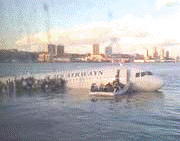Bird Strike Committee Proceedings
Date of this Version
8-2008
Document Type
Article
Abstract
How might grain-crop agriculture and stormwater-retention structures within FAA airport sighting criteria affect bird strike risk? We summarize over seven months of data (20 August 2007–31 March 2008) from an on-going wildlife hazard assessment at a General Aviation airport in north central Oklahoma, including concurrent observations at 10 stormwater-retention structures within the two-mile sighting criteria. The landscape within the 5-mile FAA sighting criteria is a mix of rural and suburban areas, but includes approximately 75% agriculture, 1,339 water bodies (315 km of shoreline) composing 617 ha of water held predominantly in private and municipal stormwater-retention structures. We conducted weekly, systematic point counts and summarized these data as median counts of individuals within an avian group (based on foraging guild and species recognized as hazardous to aviation) by site and within season. We calculated risk as a function of avian group frequency by group-specific damagecost data obtained from the FAA Wildlife Strike Database. Canada geese (Branta canadensis) predominated in counts at the airport as well as at the off-airport stormwater-retention sites (airport: maximum count = 590 birds; weekly median = 74 birds; retention ponds: maximum count = 490 birds; weekly median = 461 birds), followed by gulls (airport: maximum count = 212 birds; weekly median = 51 birds; retention ponds: maximum count = 550 birds; weekly median = 241 birds). Canada geese represented a level of risk (average across retention ponds and airport, respectively) that exceeded that of gulls by a factor of 3.6. Both groups represented a level of risk that exceeded that of the next closest hazardous group, other waterfowl (Anatidae), by at least a factor of 4.0. We discuss the implications of our findings relative to wildlife management on the airfield and the necessary collaborative wildlife-management efforts between the airport manager and surrounding landowners.


Comments
Abstract of paper presented at Bird Strike Committee USA/Canada Meeting, Lake Mary and Sanford, Florida, August 18–21, 2008.